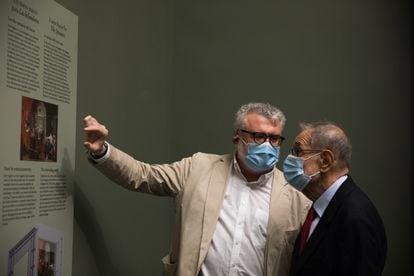Presentation of the new frame for 'Las Hilanderas', by Diego Velázquez, in the image, Javier Solana, president of the Royal Board of the Prado Museum. Victor Sainz
When visitors to the Prado Museum contemplate
Las Hilanderas
, by Diego Velázquez, they will come across the original creation, without the additions made in the 18th century that made the scene seem more remote and adopt a more traditional than mythological look. To achieve this, a large mobile panel has been installed on the work with a new frame that reduces the painting to its initial version. When an expert wants to analyze the complete painting, they can access it thanks to a simple mechanism, as if opening a safe that gives way to the entire tapestry.
The work becomes 167 centimeters by 250 centimeters, compared to the 220 by 289 centimeters that have been seen so far. The first enlargement consisted of adding a band at the top of the painting showing an arch and an oculus, as well as two bands at the lower right and left ends. Since 2017, the institution has proposed a system that respects the initial production of the painter and that allows easy access to the entire work. The result is a project that allows aesthetic integration in the room and that adds preventive and sustainability conservation: harmful products have been eliminated for the preservation of the work, recyclable materials have been used, and now there is a fire-retardant blanket and with a frame that does not cast the shadow.
Miguel Falomir, director of the Prado Museum, with Javier Solana, president of the Museum's Royal Board of Trustees, Victor Sainz
This is the first action of the project
Framing the Prado,
which has the support of the philanthropic entity American Friends of the Prado Museum, thanks to the sponsorship of the American Express Foundation, whose objective is to provide new frames for the works in the art gallery and improve the presentation of the collections. At the press conference held this Monday at the facilities, Andrés Úbeda, Deputy Director of Conservation of the Museo Nacional del Prado, announced that it is a “pioneer in the world” prototype: “There is no other similar specimen. It is more than a frame ”. On the other hand, he recalled that creations were frequently modified in royal collections: "In the 18th century the axis of this work was displaced, the vertical lines caused a certain disturbance for those who examined the painting." The reason for these additions was purely decorative,Larger paintings were needed to fill the walls of the Royal Palace.
More information
The Prado Museum never closes
The Prado Museum tells its “most personal” story in an installation of 265 pieces
Úbeda defends that the new version will alter the sensations of the visitors, since all the figures will come to the fore.
In
Las Hilanderas
, the main characters are in the background: the goddess Palas, wearing a helmet, argues with Arachne and the two compete over their skill in tapestry.
Behind them, you can see a tapestry that reproduces
The Rape of Europe,
a picture that Titian painted for Philip II. It is one of the erotic stories of Jupiter, the father of Pallas, that Arachne dared to weave, which served as an excuse for the goddess to turn her into a spider. Velázquez made this painting between 1655 and 1660, in the final stage of his career, and it was owned by Pedro de Arce —montero of King Felipe IV—. It entered the royal collections in the 18th century and was part of the select group of works hanging in the Royal Prado Museum when it opened to the public in 1819.
Javier Solana, president of the museum's Royal Board of Trustees, thanked the two institutions involved for their support and collaboration: "They make the Prado richer." The financial director of American Express Europe, Tomás Fernández, has mentioned that "since the 19th century they have been at the service of heritage, because it has a lot of value." "Our company has more than a century and a half of service to society," he said about this company that finances non-profit organizations (NGOs) that seek to preserve and maintain historic places; who carry out educational activities; or who work to promote community service. In this case, they have collaborated with American Friends of the Prado Museum, an American foundation whose mission is to support the Prado and encourage it to become known in their country through projects.Christina Simmons, its executive director, has highlighted "the commitment of American Express Europe and its sensitivity in supporting culture."

